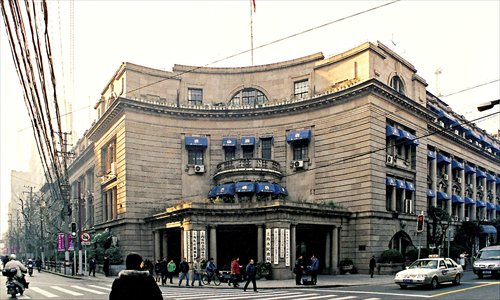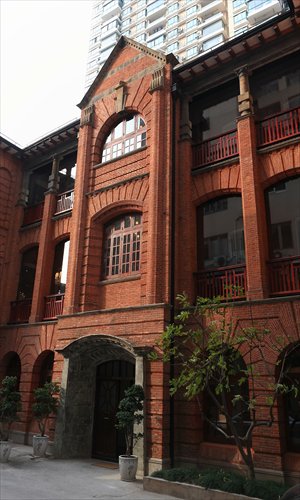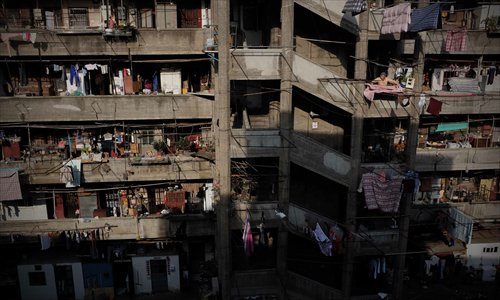Arresting developments
Editor's note
From a fishing village with a population of just 200,000 in 1843, Shanghai has developed into a huge modern city where more than 23 million people live. From the time Shanghai was forced to open up as a port in 1843, the city has witnessed remarkable change and progress. This year marks the 171st anniversary of Shanghai's opening-up and in this special series of reports, the Global Times will highlight some of the crucial moments, recall some choice memories of olden days and uncover some of the secrets of the city. Don't miss these exciting insights into the metropolis.

The Shanghai Municipal Police (SMP) was the police force of the Shanghai Municipal Council which ran the mainly British International Settlement. Formed in 1854, it enforced the law in the International Settlement and some other parts of Shanghai until 1943.
In that period its numbers rose to a peak of 6,000 active officers during the 1930s. While the SMP's composition was by no means representative of the settlement's citizens, it was a very international force - among its ranks were Chinese, English, Irish, Japanese, Russians, Scots, Sikhs, and a sprinkling of Americans, Australians, Austrians, Germans, Swedes and others. But the majority of the upper ranks were British, and most of the lower level constables were Chinese.
The Commissioner of Police was one of the best-paid officials in the International Settlement, earning 3,215 silver dollars monthly in 1934. In contrast, Chinese xunbu ("the patrol and catch men" or the ordinary police officers) were paid only 20 silver dollars a month in 1916 and not much more later.
The favored nations
Ironically, there was no single "law" for the SMP to uphold; treaty agreements between China and the 14 "favored nations" resulted in a judicial system known as "extraterritoriality." That is, an accused citizen of a favored nation (the US, Belgium, Brazil, Great Britain, Denmark, France, Italy, Japan, the Netherlands, Norway, Portugal, Spain, Sweden and Switzerland) had to be brought before a judge or consular official of his own country. Chinese and foreigners without extraterritorial rights were brought before Chinese courts.
For example, the British in Shanghai had their own supreme court and the Americans had a United States Court for China. If a Chinese wanted to sue an American, he had to do so in the American court, and if an American wanted to sue a Brit he had to go to the British court.
The SMP was initially based at the Central Police Station on Hankou Road, but soon expanded. By the 1940s, the SMP had 14 stations, or xunbu fang, divided into four divisions. One division, for example, included the Central Police Station, which later moved to Fuzhou Road, and the Louza Road and Chengdu Road stations.
The Central Police Station on Fuzhou Road was completed in 1935 as a four-building complex with dormitories, reading rooms, billiard rooms, shops and cells. In one of the buildings, the first two floors were offices and interrogation rooms, the third floor housed a canteen, and the fourth to eighth floors were dormitories for Western staff. The Chinese police dormitories were in another building.
After the British left, the Fuzhou Road complex became the headquarters of the police department under the control of Wang Jingwei, the president of the Japanese-backed puppet regime. Today it is a building of the Shanghai Municipal Public Security Bureau.
The Louza Police Station was established in 1860 on Guizhou Road, initially to maintain order after the Taiping Rebellion (1850-64) which saw large numbers of refugees flocking into the concessions. A big contingent of Sikh policemen was stationed there and locals referred to it as "the red-head police station" (the Sikhs wore red turbans).

Violent clashes
Because of its locale and composition old Shanghai attracted criminals of all sorts and descriptions. Some of them were petty but many of them were dangerous - kidnapping, murder, and spying were commonplace. Violent clashes between police and criminals were frequent. Crime rates soared in the early 1920s. In 1922, 47 armed robberies were reported in the International Settlement. Two years later, the number had increased more than fourfold to 204 armed robberies, and by 1926 there were 448.
In 1933, the force recorded one officer killed in the line of duty and eight wounded, while police admitted killing 11 criminals and wounding 13. That was regarded as a quiet year.
Frederic E. Wakema's book Policing Shanghai, 1927-1937, quotes the Shanghai Municipal Police Commissioner F. W. Gerrard who, in 1930, wrote: "It is certain that Shanghai will continue to be highly criminal till such time as it is thoroughly cleansed of its worst evils: (1) illicit trade in opium, (2) gambling, (3) general looseness in forms of life, all of which not only attract and hold criminals to the place, but put in the hands of the principals enough money to maintain hordes of loafers in their pay and to defeat justice."
A 1940 Shanghai Municipal Police document records that over 50 policemen, including Chinese, British, Indian and Japanese inspectors and constables were awarded Distinguished Conduct medals that year.
A policeman called Mal Singh received a medal for his "great bravery and devotion to duty when attacked by a gang of armed assassins at the light standard at the intersection of Edinburgh and Yu Yuen Roads on October 20, 1939," while a Chinese policeman Peng Ching Sheng was honored "for outstanding courage, personal initiative and devotion to duty during a large scale shooting affray between police and armed criminals on Peking Road on the evening of February 1, 1940." Judging from the document, gang crime, bombing and assassins were commonplace through the 1940s.

Martial arts
One memorable character of the Shanghai Municipal Police was William Ewart Fairbairn who was born in 1885 in Rickmansworth, England. He joined the British Royal Marines at 16, and after serving six years, including time in Korea, joined the SMP in 1907.
When he was patrolling the streets in Shanghai, the young sergeant was attacked and beaten up by a Chinese gang and he almost died. This spurred him to study self-defense techniques. From 1908, he trained extensively in various martial arts, including baguazhang, jiu-jitsu and judo, from Chinese and Japanese instructors. From these experiences he developed defendu, a style of combat he designed especially for police use.
Fairbairn became the SMP's chief instructor in close combat techniques and was in charge of writing the manuals on shooting and pistol techniques. He also formed the Reserve Unit in the 1920s, recognized by some as "the world's first SWAT unit." The unit was intended to quell uprisings and riots and also handle special crimes, including kidnappings and armed robberies. The unit received special training, and many of the policemen in the unit were martial arts masters who were specially selected for this work.
Fairbairn retired from the SMP in 1939 and during World War II he trained British, American and Canadian commandos. In over 30 years with the SMP, he was personally involved in more than 600 violent encounters.
The British employed a large number of Indian policemen in the International Settlement, most of whom were Sikhs, who stood out in the city with their red turbans and height. According to Isabella Jackson in her paper "The Raj on Nanjing Road: Sikh Policemen in Treaty-Port Shanghai," althoiugh Chinese were recruited to the force from 1864, the idea of recruiting Sikhs first emerged in 1883 when the Shanghai Municipal Council sought to increase the size of the SMP.
The SMP was considering one European constable for every two Chinese, but, as the cost of Europeans was significantly higher, it was then proposed to employ Indians who were paid much less. Indian Sikhs, who were generally well built, were considered ideal.
Shanghai locals called them "red-headed asan." There are different explanations of this: some say san may have derived from "sir," or police, and others say it was a transliteration of "I see," which Sikh policemen were often heard saying to their British superiors. Another explanation says that san, which means "three" in Chinese, was a derogatory term for an Indian man, with no actual meaning.
Traffic duties
Although the Sikhs' duties involved preventing and solving major crimes, most of them were given the arduous job of regulating the traffic, which is probably the biggest impression they made on people in Shanghai. In Tintin's adventures in The Blue Lotus, for example, Hergé shows a Sikh as a traffic policeman in Shanghai.
As China's first modern city, Shanghai's traffic was notoriously chaotic, with cars and trams sharing the road with rickshaws, carriages, wheelbarrows and pedestrians. According to the annual report of the Shanghai Municipal Police in 1916, by that year there were 3,000 rickshaws per square mile in the settlement and the drivers constantly disregarded the rules of the road. Traffic lights didn't appear until the 1930s.
The Sikh police tried to bring order to the chaotic roads. This wasn't an easy job. Many of them had to stand on duty for up to 12 hours and their efforts were often ignored, according to Jackson. This is probably why many of them often used their batons to strike out at Chinese pedestrians and rickshaw drivers who tried jaywalking or turning the wrong way. This resulted in a general resentment towards the Sikhs from the Shanghainese, who regarded them as the minions of the British and joked about their skin color.
The Shanghai Municipal Police was not the only police force in Shanghai at that time. The French Concession had its own police force, consisting of 250 French officers, dozens of French and Chinese detectives, 1,800 Chinese policemen, 1,200 Vietnamese guardsmen, and a heavily armed auxiliary unit composed of 500 Russian mercenaries, according to an article in Pyramid magazine by Hans-Christian Vortisch. However, the police forces rarely had any dealings with each other.